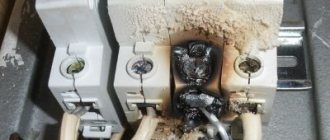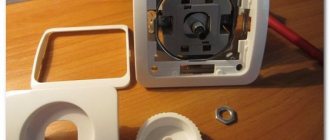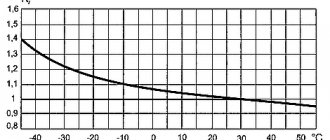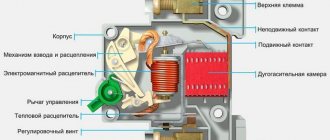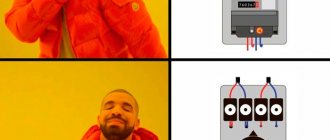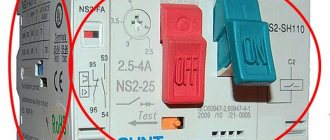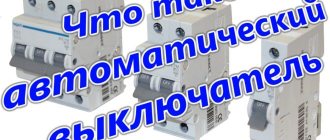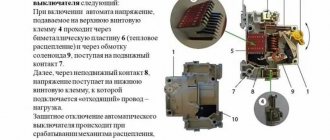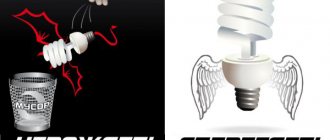Very often we are faced with such a problem as the sudden appearance of an abnormal operating sound from a circuit breaker in the panel room.
A slight hum from an electromagnetic starter surprises few people, and some even consider this effect to be its usual mode of operation, although this is not the case for new devices. So what should you do when your machine buzzes like this or buzzes?
Is it worth changing it right away, or is the reason not in it at all, but in the electrical wiring or connected load? Let's take a closer look.
First of all, remember that all machines installed in a panel under normal operating conditions should never make any sounds.
If this sound appears, then first of all decide what it sounds like:
- hum
- buzz
All your further actions will largely depend on this.
Such sounds appear when the machine is energized and under load. That is, current flows through it. Moreover, the greater the load, the louder the machine can make noise.
What to do if vibrations occur?
They often occur when current is applied to a coil or bimetallic strip, which creates an electromagnetic field that acts like an electric magnet on the metal parts inside. Electromagnetic influence provokes vibrations.
Read also: What to do if you get burned by a stove
Even if the vibrations are almost imperceptible, this is also a malfunction. If you feel a slight tremor when you touch the body with your finger, it means the mechanism inside is defective, which is dangerous for further operation. In this case, it is highly recommended to make a replacement.
Purely theoretically, a circuit breaker can serve you for several more years, but there is no guarantee that the circuit will break during a short circuit. Moreover, constant vibration will over time weaken the connections more, causing the machine to jam, trigger falsely, or even fail. In any case, this is dangerous, so replace it with a new one as soon as possible. The only thing worse than vibrations is crackling. In this case, replacement is needed immediately .
What causes the buzzing, and what to do in such a situation?
The fact is that alternating current flows in the network with a frequency of 50 Hz, which means that electrons move along the core in uniform waves occurring 50 times per second. Due to this movement, vibration of conductive parts occurs, the sound of which you hear.
The human ear detects any sound (air vibration) in the range from 20 Hz to 20,000 Hz. Microvibration at a frequency of 50 Hz is quite perceptible to our ears.
Oscillations occur due to poor contact of conductive parts. This problem often appears due to manufacturing defects or shocks and falls during transportation, careless storage, etc.
Usually, a long beep does not mean that the protection will fail at a critical moment, but still the characteristic sound indicates a malfunction. In this case, it is better to make a replacement, even if you checked the functionality yourself and an electrician you know said that “it’s okay, it’s normal.”
Any, even minor, malfunction often causes the release to fail in a critical situation.
Considering that a circuit breaker, even from a good German brand, is now easy to buy for just $5, it’s better to do so. You can easily verify this - on the website of the Axiom+ online electrical store there are always current prices for German Hager automatic machines. This is a small price to pay for protection against overloads and short circuits, which often cause fires.
Along with the humming, sometimes a slight shaking of the body is also felt.
Causes of noise from a new meter
It happens that in a completely new house, where there is new wiring and stable voltage, there are no problems with electricity, the electric meter suddenly begins to hum. If everything is clear with old devices, then with new ones things are somewhat more complicated. First, let's look at what you shouldn't do with a new energy metering device:
- break the seal. If this has already been done, you must call and inform them of the need for a new sealing;
- disassemble the electric meter yourself;
- put a high load on the device, from which sparks are already flying;
- when sparking, climb into a working device;
- knock on the meter, rearrange, pull wires.
The machine crackles under load
The crackling noise heard from the device always indicates the presence of sparks. Most often they occur when the moving and fixed contacts or terminals at the place where the wires are connected are worn out.
If in a working device all connections are tightly adjacent to each other, then when the connection terminals or contact group burn out, the electric current passes through soot, an air gap or point contact of conductive elements.
The flow of current through damaged areas is always accompanied by heating and further destruction of the connections, and if this process goes far enough, then sparks and the accompanying crackling noise are added to it.
Therefore, such a sound indicates the need to immediately turn off and replace the circuit breaker. Otherwise, it is possible not only for the device to fail, but also for it to catch fire and destroy the entire electrical panel.
Device
Here you will not find ordinary lamps that are screwed into a socket. It consists of dozens, perhaps even hundreds of small LEDs, which in total produce a fairly large luminous flux. A distinctive feature of such a product is a different switching principle - if in the classic version, operation requires a mechanical switch, which, depending on the position, closes or breaks the electrical circuit, here a special relay is installed with a detector that picks up the signal from the remote control.
Relay with remote control
Depending on the button pressed on the remote control, the relay works with the controlled contacts, as a result - they turn on or off. The photo above shows a combination of remote control and relay, which allows you to operate in several modes:
- Turns the first diode block on and off, usually 30–40% of the total.
- Turning on and off the second block, respectively - 60–70% of the light bulbs.
- Turning on all 100%, and one off button for all three modes.
Depending on the size of the chandelier with LEDs, it is possible to increase or, conversely, decrease the modes. All LEDs are connected in series, with a capacitor in front of them. It acts as a barrier, protecting fragile crystals from sudden voltage fluctuations.
It rarely consists only of LEDs; usually they are used there in the first mode as a night light or simply decorative lighting. The main light is realized using several small but powerful halogen bulbs (LEDs also enhance the main light). Halogen lamps are connected using one or more special transformers (depending on the number of bulbs and their power).
Chandelier with combined lighting
Repair of halogen chandeliers is carried out similarly to the repair of LED chandeliers. Each element will be described in more detail below when we begin to analyze the causes of the breakdown.
Reasons for heating
Any circuit breaker gets hot during operation. The reason for this phenomenon is the built-in thermal protection, which turns off the machine when overloaded.
The operating element of this release is a bimetallic plate, which bends when heated. The end of the plate presses on the switch mechanism, which causes the protection to operate.
The thermal release is heated when electric current flows through it, which is why the machine is always slightly warmer than the environment, but its temperature should not exceed 60-70°C .
If the body of the device is heated above the permissible temperature and the device frequently turns off without exceeding the load on the line, then the cause of overheating is most likely poor contact of the connected wires in the terminals of the device.
The main problems with automatic machines
The machine has only three main faults:
- Knocks it out.
- Doesn't turn off.
- Doesn't cock.
The machine knocks out - this means that either suddenly, without obvious reasons, the voltage disappears, or when you turn on the load in one of the circuits, the power supply network is turned off. The machine may also not turn on in different ways:
- When the lever is cocked, it immediately goes down, the voltage appears briefly or does not appear at all.
- The lever is jammed and does not cock and does not work at all.
- If you hear a burning smell or the wires are burnt out from the circuit breaker, you need to turn it off before starting the repair, but the lever simply does not budge, as described in the previous paragraph, only in the on position.
Electrical circuit breaker malfunction
Your circuit breaker trips periodically. The probable reasons for this are as follows:
- Short circuit in the circuit;
- Network congestion;
- Damage to wires periodically leading to either a short circuit or overload.
First you need to diagnose the electrical network for overload and short circuit. If these faults are not detected, and the machine still turns off, then a malfunction of the circuit breaker itself is very likely.
Why does the machine heat up?
The fact is that all household series operate on a thermomagnetic release. Under load, it heats up and as soon as the temperature exceeds the permissible value, the contact plate is deformed and activates the release mechanism, breaking the circuit.
To be fair, it should be said that all machines heat up under load and this is a normal phenomenon. The higher the load, the more the release heats up and the faster the circuit breaks. For example, if a 20A machine starts to pass 23A, then after half an hour it will turn off the network, at 25A this will happen after 5 minutes, and so on. There are several reasons for strong heating:
- Poor condition of contacts - when the contact strip is loosened, the basic throughput deteriorates, causing it to become very hot;
- Wear of the release mechanism - over time, parts wear out, their basic characteristics, including throughput, decrease;
- Poor assembly - low-quality machines, as a rule, have characteristics lower than declared. They do not pass the maximum current for which they are designed, which is why they become very hot;
- High load - the thermal release reacts to the overload protection, and it takes time to heat up, and the plastic case also heats up with it.
Each manufacturer has its own standards for permissible heating temperature, but usually it is from +55°C to +70°C, which is safe for use. You can always check the heating limit in the technical data sheet.
If you notice that the heating level is noticeably higher than +70°C, and light traces of melting are visible on the body or the handle is stuck, then this is an emergency. In such a situation, it is better to replace the machine with a new one. If you ignore it, at best the shield will burn out, at worst there will be a fire in the apartment.
If any of the problems occur, replace the machine. Don't take risks and don't try to repair it.
Why you can’t repair a machine yourself
The fact is that no household machine is designed for repair at all. Based on the relatively low cost, manufacturers simply do not consider this option as it is not economically feasible.
Premium series of popular 16-amp single-phase Hager or Eaton in everyday life cost less than $10. Even with a slight breakdown, it will be cheaper to throw it away and replace it with a new one than to repair it. No service center does this, and don’t try it.
After self-repair, the consequences may be worse than before. You will have to open the case, which means compromising the integrity of the structure. The likelihood that the release mechanism will work properly after this is negligible. Moreover, after disassembly, nothing will hold securely there, which means an accident can happen at any moment.
Even such a minor (at first glance) breakdown as a dropped handle indicates mechanical defects. They often occur due to damage during transportation. There is no guarantee that everything else inside is working properly, so it is dangerous to put such protection in your shield.
Sometimes the main cause of breakdown is a manufacturing defect, which is often found among Chinese manufacturers.
Why are Chinese machines so unreliable?
Everyone understands that the only advantage of the “Chinese” is low cost. But it is achieved precisely by saving on materials. Budget Chinese models have cheap everything: plastic, metal, release mechanisms.
The most “trash” models often lack an arc chute. So, under high loads they do not spark, but immediately burn.
All these reductions in price will sooner or later come out sideways. For example, even due to elementary savings on rivets, the strength of the entire structure is lost. As a result, some parts fall off over time and the cocking mechanism weakens. This causes the problems listed above and will require replacement soon.
Electricians often swear at the “Chinese”. In fact, if you take the cheapest ones and take them apart to see what's inside, you'll be surprised how they even work. They usually have a lightweight design, thin springs, power contacts that barely hold, and other obvious problems. This doesn't inspire confidence.
Even worse are Chinese counterfeits of well-known brands, sold below the cost of the originals. Unfortunately, there are a lot of them on the CIS market. It is quite natural that the most popular brand, ABB, has the most counterfeits. This is a Swedish-Swiss manufacturer that produces fairly high-quality machines. Accordingly, you yourself must understand that they will not be too cheap.
To achieve high reliability and quality of releases, more expensive metals are needed: sputtering of silver, gold, etc. In addition, Europeans usually do not skimp on materials. There will definitely be an arc chute there and a heat sink will be made. And all this increases the cost, so there are no good machines cheaper than $3 .
Noise in household appliances
The effect of magnetostriction on network transformers operating in household appliances is negligible, so the causes of humming in most cases indicate an abnormal situation.
Why is a transformer humming in the AC network? What is the cause of annoying sounds and what to do to get rid of them?
In lamps and chandeliers, the phenomenon occurs due to the high power of 12-volt halogen bulbs. To get rid of the undesirable effect, you need to reduce the power of the lighting sources or install a higher-power electronic transformer (this does not always help, sometimes you just need to buy a high-quality and expensive power source).
If a whistle is heard on a brand new TV with the receiver properly configured, most likely its source is poorly assembled transformers or chokes. It is necessary to additionally solder the parts and, to eliminate vibration, fill the windings with glue or tsaponlak.
The transformer included in the power supply device for the LED strip has one big drawback. It squeaks under heavy load, and even more often the squeak is heard when dimming. The problem goes away after installing a sealed power supply, through the housing of which, in simple words, sound simply does not penetrate. You can also try to find a dimmer with a high PWM frequency on sale.
If the subwoofer is humming, the problem may be a faulty smoothing capacitors of the power supply and a faulty sound amplifier. Then a constant hum occurs in the speakers, which can be eliminated by replacing worn-out parts. If the amplifier elements are in good condition, then you should increase the capacity of the filter capacitors after the diode bridge in the power supply; an excessive increase can lead to failure of the diode bridge at startup.
If the microwave hums and vibrates when turned on, the power transformer most likely has failed. Before touching the internal elements, you need to turn off the power and forcefully discharge the high-voltage capacitor through the light bulb. Damage can occur in both the primary and secondary windings. In this case, it is better to contact the service center.
If the microwave is cracking, the problem may be high-voltage faults. This is usually “treated” by removing dirt and touching up those parts of the body (inside the microwave) from which the paint has fallen off, or by replacing the mica.
A squeaking sound in a 12-volt charger is also observed when parts are poorly secured or if the charging current is set too high. It is also possible that it is time to change the battery, since the plates of its cans have short-circuited among themselves. Over time, if this is a manufacturing defect, vibrations of these elements can loosen the soldering, forming increased contact resistances in this place, which, under the influence of current, will heat the entire area. This may cause a short circuit and a fire in the charger. In this regard, if a problem occurs, it is better to immediately change the device to a new one.
So, let's summarize. If the power transformer at an electrical substation hums evenly, without sudden sharp sounds, this is a normal natural process of operation. If we hear a device humming that has never made such sounds before, we need to start repairing it.
If you do not have the necessary knowledge and experience, you should not interfere with the device. It may be dangerous. Trust the professionals.
The machine buzzes in the control panel under load
It happens that when you turn on a specific electrical appliance in the apartment, for example a multicooker or a lighting system using energy-saving lamps, or the power supply of a specific electrical appliance, the circuit breaker in the electrical panel begins to buzz. Moreover, this phenomenon is usually not associated either with the increased power of the connected consumer, or with the corresponding current approaching the nominal value of the machine. And it is associated with a certain power or with a certain household appliance.
In some cases, the hum disappears completely with increasing load power, and often the owner of the home has no complaints about the smell of burning... This means that it is not the arc that is humming inside the machine. And then what? Where does this hum come from? Is he dangerous? How to fight this phenomenon and is it worth fighting it at all? Let's think about this.
What's buzzing there?
Anyone who is familiar with the design of a circuit breaker knows that two protective tripping mechanisms are simultaneously implemented inside it: thermal and electromagnetic.
The thermal release mechanism is based on the gradual deformation of a bimetallic plate, which, heated by the overload current passing through it, bends; this process is relatively inertial, however, if the current is equal to the nominal value of the machine, then after a few seconds the deformed plate will press on the trigger mechanism, and the charged spring of the switch will open the circuit .
The electromagnetic release mechanism is designed for the event of a short circuit; it is designed to instantly open the circuit when, during a short circuit, the current through the electromagnetic coil reaches such a value that a spring-pressed iron core is sharply retracted into this coil, which, when retracted, presses on the same spring-loaded switch - the circuit again it suddenly opens.
So, since the bimetallic plate cannot hum, it does not participate in magnetization, but is only heated by the current passing through it, therefore the hum of the machine is associated with the coil.
Indeed, the iron core of the coil is always in the magnetic field acting in the protected alternating current circuit. If the core is not pressed securely enough by the spring, if there is some play inside the circuit breaker body, then under certain conditions this core will indeed emit a rather noticeable hum.
Why is it buzzing? What are these conditions?
Firstly, if the shape of the current in the coil surrounding the core is distorted by a pulsed load connected to the network, producing pronounced peaks from transient processes, then the magnetostrictive effect of such peaks will inevitably generate noise from the iron core of the machine’s coil.
Secondly, if the core, even in the cocked machine mode, falls into the saturation region, then it will also hum.
Thirdly, if the core still has a strong backlash, it can transmit vibration to the plastic body of the machine and to other elements of your shield.
Thus, when three conditions are combined: core saturation, strong backlash, and the presence of impulse noise, we will theoretically hear maximum noise.
Who is to blame and what to do?
The answer to the question about the cause of the hum is logical: the manufacturers and developers of the humming machine did not provide for all the possible nuances associated with how the core will behave when the machine is cocked. And there is only one way out here. If you don’t want to put up with noise, then you need to purchase a machine whose coil core does not hum from interference, backlash, or possible saturation, and if it hums, it’s not very loud. If the hum does not bother you too much, you can leave the humming machine alone.
Very often we are faced with such a problem as the sudden appearance of an abnormal operating sound from a circuit breaker in the panel room.
A slight hum from an electromagnetic starter surprises few people, and some even consider this effect to be its usual mode of operation, although this is not the case for new devices. So what should you do when your machine buzzes like this or buzzes?
First of all, remember that all machines installed in a panel under normal operating conditions should never make any sounds.
If this sound appears, then first of all decide what it sounds like:
- hum
- buzz
All your further actions will largely depend on this.
Such sounds appear when the machine is energized and under load. That is, current flows through it. Moreover, the greater the load, the louder the machine can make noise.
Let's look at the first fault, namely humming. If your machine makes a sound during operation like a starter or contactor, this indicates a defect or defect.
Do not look here for damage to electrical wiring, bad contacts, etc. A humming machine definitely needs to be changed.
Although this does not mean that his defense will not work as it should.
It can still shut down properly and operate during short circuits.
But how long it will work like this - a month or two, or it will burn out at any moment, you will never know in advance.
Moreover, if in the electrical panel it stands in one tight row with other intact circuit breakers, its sudden damage or ignition will lead to the failure of all neighboring switching devices.
Therefore, it is better not to delay the replacement and immediately buy another one. Do not listen to the advice of those who recommend simply knocking on the machine body with some blunt object.
For example, the back of a screwdriver. Apparently after this the sound disappears.
Replacing a machine is not such a difficult job, and many people do it even under voltage.
Also, do not try to repair or disassemble it yourself. Such modular devices are made disposable and cannot be restored at home.
They are assembled not with screws at all, but with rivets. These rivets can only be drilled out.
If you do this, you will see the following picture inside.
Principle of operation
During our school years, in physics lessons, we were taught the concept of magnetostriction. Not everyone, however, was interested in it then. Let us now try to return to the topic and briefly outline the essence of the process. First, let's remember how a transformer works.
The figure shows the simplest device, consisting of a primary winding (A), a secondary winding (B) and a core (C) - a magnetic circuit assembled from metal plates or from a material with ferromagnetic properties.
When an alternating voltage is applied to the primary winding (A), a current begins to flow in it, under the influence of which a magnetic flux (F) is formed in the core (C), inducing a current in the secondary coil (B), to which the load is connected. A voltage conversion occurs, the value of which at the output will depend on the ratio of the number of turns of the primary and secondary windings. The frequency will remain unchanged.
Magnetostriction is a physical process of changing the volume and size of a body under the influence of a magnetic flux passing through this body. Materials with pronounced magnetic properties, from which cores for transformers are produced, are subject to changes.
The figure shows the periodicity of the process of compression and stretching of the core during a cycle of changing magnetic flux. Changes in the size of the magnetic circuit lead to air vibrations. Waves are formed that have a frequency in the audio range (50 Hz). This is the same hum that accompanies the normal operation of power transformers. In SMPS (switching power supplies) there is no such noise, since the frequency of the waves generated during the oscillation process is not included in the human audible range.
What to do if your heat meter is broken
When you pay your next utility bill, you suddenly receive an amount that is slightly more than what you paid last month. When you make a verbal complaint, they will explain to you that you have to pay more because the meter is broken. Before paying an unfairly inflated payment, you should write a written request to clarify the situation and ask for a full recalculation of the payment.
Once you receive a response, you either challenge the decision or pay the bills. An excellent option would be if other apartment owners also come with a written appeal, so the proceedings will end in your favor.
This article described in detail what should be done if the device buzzes loudly, and also touched upon the topic of how to pay if the heat meter is faulty. We hope our advice will be useful in life. We wish you success!
Many people, when purchasing private houses, dachas, cottages, often encounter this problem - the meter crackles or hums loudly. It can hum loudly, crackle at certain periods: when some electrical appliance is operating, it sparks, creaks, and so on. Let's try to figure out why the electric meter is humming.
Rumble in the building
Most often, this problem does not require any action, especially if the circuit breaker is located in a non-residential area. The reason why the machine hums is due to loose fastenings of the electromagnetic release parts, which does not affect the protective properties of the device.
If the sound coming from the case interferes with sleeping or listening to TV, then the device must be replaced. Repair in this situation is only possible by disassembling the case, which is not provided by the manufacturers.
Recommendations
To ensure that the equipment works for a long time and properly, listen to the following operating recommendations.
- Surround, clear and loud sound is only possible when using high quality equipment. You shouldn't demand much from cheap acoustics.
- Transport speakers carefully by packing equipment using boxes, foam, bubble wrap, and other options.
- Update your driver regularly.
- Acoustic equipment quickly becomes unusable due to high humidity.
- Make sure that the cables are not under too much tension.
To learn about the reasons why speakers hum, see the following video.
Overload shutdown
First of all, it is necessary to analyze what load was connected to the electrical wiring lines that are connected to this machine. For example, a circuit breaker powers two outlets located in one of the rooms of the apartment. An electric heater was plugged into one outlet, and a vacuum cleaner was plugged into another. In this case, it is necessary to determine whether there was an overcurrent or not. To do this, it is necessary to compare the load current of household electrical appliances with the permissible load current of the circuit breaker (rated current).
The power of the electric heater is 2000 W, and the power of the vacuum cleaner is 1500 W. Having made simple calculations, we obtain the load current of these electrical appliances - 9 and 7 A, respectively, the total load in this case is 16 A. In the apartment panel, to protect the electrical wiring line feeding these sockets, a circuit breaker with a rated current of 16 A is installed.
Based on the fact that the load current does not exceed the rated value for the circuit breaker, we can conclude that there was no overload.
Otherwise, that is, if the load current is greater than the rated current of the circuit breaker, then the automatic shutdown of this device was due to overload.
It should be noted that re-closing the circuit breaker after tripping due to overload can be done a few minutes after it has been turned off. This is due to the fact that the thermal release (that element of the machine that protects against overload) is heated in the activated state, so in order for it to return to its original state it needs to cool down.
When turning off the circuit breaker, you can touch its body. If the housing is warm, this indicates that the thermal release has tripped, that is, a shutdown due to an overload in the electrical network.
Introduction. Carpentry workshop
Sano published a blog entry in Furniture made from slabs, solids, and various differences, September 27, 2022, blog entry
So I have reached my workshop, which still needs a long and hard time to be equipped and supplemented with various tools.
But the main thing is to have a warm room, although not your own, somewhere to work until they kick you out.
https://www.youtube.com/watch?v=ytcreatorsen-GB
This warehouse is quite spacious, if you remove everything that is not needed, so you will have to do a lot to even get started with work. And the first thing I did was take out the excess and start assembling a large desktop.
Short circuit mode
If the machine is knocked out during a short circuit, this means that an electromagnet has been activated, which serves to instantly break the electrical circuit. In this case, the wiring does not heat up to a dangerous temperature.
When the power contacts open, an electric arc appears. To prevent them from collapsing, a chamber is provided to extinguish the arc. It is made in the form of a lattice of metal plates isolated from each other. On them the arc is crushed and extinguished.
Circuit breaker arcing chamber
Before turning on the machine again after a short circuit has occurred, its causes should be found and eliminated.
We independently identify and fix the problem
If the machine is “knocked out” when several household appliances are turned on at once - an electric stove, a washing machine, a vacuum cleaner, an electric kettle, a boiler and others - the problem is a thermal disconnector or a power surge . In this case, the machine turns off to protect the network. You need to know what the power of the connected electrical appliances in your home is.
Read also: Waiting for cache, what does this mean? —
Listen - if the machine makes a characteristic noise and crackles, this is a sign of its overload. In this case, it is necessary to turn on household appliances one by one. It doesn’t help - we look at the machine, and if burnt wires are found there, it means that the problem is in the thermal disconnector , which has failed due to overheating of the power contacts (they cannot be cleaned) or loose wires in the terminal blocks (they can be cleaned and tightened). Manufacturers mainly make them non-separable, and only some provide the possibility of disassembling and adjusting them. Therefore, you will have to buy a new AB.
How to choose a good circuit breaker
You probably already realized that first of all you should pay attention to European manufacturers. Everyone knows them: Hager, Schneider, ABB, Eaton and others. Even their budget series are head and shoulders above their Chinese counterparts.
Cheaper means worse?
One point is important here: the concept of “budget” is different between Europeans and Chinese. If the Chinese save on materials in order to reduce costs, then their European colleagues have a different approach:
- Instead of two self-clamping terminals, use one. Because of this, installation is more difficult, but the performance is not reduced;
- Remove color indicators. They are not always necessary at home, but the cost of production is cheaper;
- Inability to connect accessories. Without additional connectors, the price will be lower.
It turns out that in the end the “filling” becomes simpler, but no less high-quality. Therefore, if you buy a budget one, try not to buy “China”.
Don’t the “top” manufacturers have any defects?
Among “Europeans” it is very rare, but marriage also occurs. Therefore, before purchasing, do a visual inspection:
- The case must be intact, all fastenings are in place, and the terminals are not loose. If everything is not in order, it means it has probably been dropped or, even worse, taken apart. Then, take something else;
- All markings and the brand logo are applied with a laser, so they should not be erased. If the paint is a little smeared or worn out, then it is most likely a fake;
- A good machine gun should not be too light. The greater the weight, the more metal the manufacturer used in the mechanism, which means higher reliability;
- Click the handle. It should change position with medium pressure . If it sticks or moves too easily, this indicates defects in the design.
Also be sure to look at the technical data sheet to look at the breaking capacity. This is the main indicator of reliability.
The machine knocks out: what are the reasons?
Now let's move directly to the question of why the machine gun knocks out in the dashboard. The machine may be triggered for the following reasons:
- Overload in the electrical network.
- Failure of one of the devices included in the circuit.
- Light fixture failure.
- The safety device is faulty.
- Short circuit.
Any of the listed reasons can lead to the AB knocking out. Let's take a closer look at each of them.
Overload
This is the name of the situation when the amount of current in the circuit exceeds the rated value for which the protective switch is designed. For better understanding, let's give an example.
To work with socket groups, AVs are mainly used, the rated current of which is 16 - 25 A. This indicator corresponds to a total power of 3.5 - 5.5 kW. Let us assume that an electric stove with a power of 3 kW, an electric kettle of 1.3 kW, and a microwave oven of 2 kW are connected to the socket group, for the protection of which a 25 A circuit breaker is installed.
If we add up the power of the listed household appliances, we get a load value of 6.3 kW. Considering that the maximum load withstood by the protective device is 5.5 kW, turning on all three devices at the same time will result in the machine being knocked out.
To avoid this, you should not take the calculation of the total load in the circuit lightly. If connecting a device to an outlet group would result in the total wattage being exceeded, it should be connected to a different circuit.
An example of incorrect wiring calculations in the video:
Do not try to solve the problem by installing a machine designed for higher power. If its rating exceeds the cross-section that the electrical wiring can withstand, problems are inevitable. In this case, the cable, under the influence of too much current, will heat up until the insulating layer melts and causes a short circuit, and in the worst case, a fire. The machine will continue to supply current to the circuit until a short circuit occurs. Therefore, if a cable with a cross-section of 2.5 mm² is used when laying a line, the AB rating for its protection should not exceed 16 A (for an aluminum conductor) or 25 A (for a copper conductor).
Troubleshooting when a circuit breaker trips: algorithm of actions
Without a special reason, the machine will never turn off, which means that there is an emergency situation that caused the circuit to be de-energized. Therefore, before turning it on again, you need to understand why it worked, detect the problem, and fix it. Only after this can the device be put into working condition. Let's look at the two most common triggers and the troubleshooting algorithm.
The machine responsible for the line of sockets knocks out
- Immediately after the protection is triggered, all consumers should be disconnected from the sockets connected to this circuit breaker. It is worth estimating the total load that was connected. There is a possibility that there was an involuntary overload of the line. This must be taken into account, and in the future it is necessary to prevent the simultaneous inclusion of a large number of consumers.
- Turn on the machine; if the protection does not trip again, then most likely there is a line overload or a short circuit in any of the electrical appliances. If the protection device does not turn on, then we can talk about a short circuit either in the socket contacts or in the supply cable itself.
Procedure if the circuit breaker trips without load
- Inspect the sockets for burns; if any, disassemble or replace them.
- A visual inspection did not yield anything, then it is worth assuming that there was an insulation breakdown in the supply wires.
- Possible weak contact or malfunction of the machine itself. After fixing the problem or replacing it, you can try to apply voltage to the line.
Procedure if the machine turns on without load
- Turn off the protection device and connect one of the electrical appliances that was previously connected to the same outlet.
- Turn on the circuit breaker; if it trips again, then this device is faulty. If the operation does not occur, then turn on in turn all the consumers that were working before the protection was turned off. This way you can find a faulty electrical appliance.
Automatic protection is triggered, responsible for the lighting line
A fault in the lighting lines is usually detected when the chandelier is turned on. Everything is immediately clear here, but this situation does not always happen. What to do then? The algorithm of actions is simple and quite accessible to anyone:
- Switch all switch keys to “Off” mode. This de-energizes the phase wire going to the lamps.
- Unscrew the light bulbs, inspect them and the sockets - usually after a short circuit there are traces of soot on the lamp and base. Where such consequences are found, that is where the malfunction occurred. The lamp must be dismantled, the condition of the wiring and socket inspected, and replaced if necessary.
- When nothing suspicious is found on the lamps and sockets, turn on the machine. If it works again, then you should look for a short in the wiring itself. This can happen either in the junction box or anywhere along the line. The second option is that the circuit breaker has turned on, which means we move on.
- Now it’s time to turn on the lighting one by one; if the machine is triggered on some key, then you need to look for a breakdown in the wiring of this lamp.
- If after turning on the switches the protection does not work, you need to screw all the bulbs into place and try to turn on the keys one by one. This will help identify the defective bulb.
When performing any troubleshooting work, be careful and careful, because repeated short circuits are possible. If you have the slightest doubt, it is better to contact electrical specialists who have experience in such work.
Cracking noise during operation
This sound indicates poor contact between pins or terminals. To determine the location of the fault, you need to inspect the terminals and wires. In this situation, two options are possible:
- The terminals have not melted, the insulation of the wires is unchanged. In this case, the cracking noise is caused by worn contacts of the contact group; they cannot be replaced or repaired and the circuit breaker must be replaced.
- The plastic near one of the terminals has darkened or melted, and the wire insulation has also become burnt or darkened. Such signs indicate poor contact and/or poorly clamped wires . Most likely, the device will have to be replaced, but before changing the machine in the panel, you can try to solve the problem by removing the damaged section of the wire and reconnecting it to the machine. After repairs, you should periodically monitor the device and replace it at the first sign of burnt terminals.
| Information! Cracking and overheating may be accompanied by the smell of smoke or burnt plastic. |
